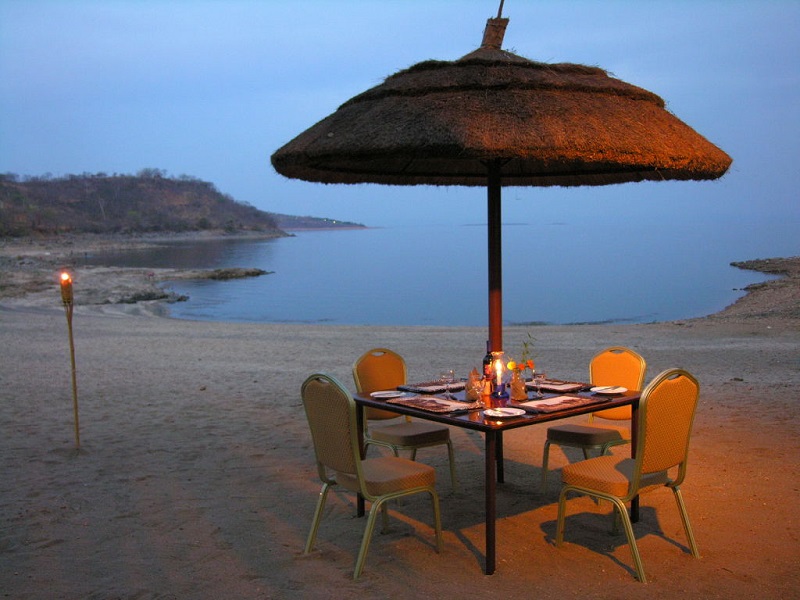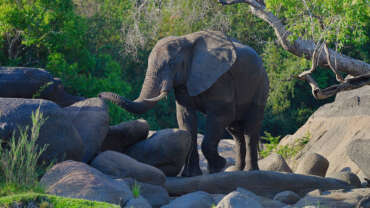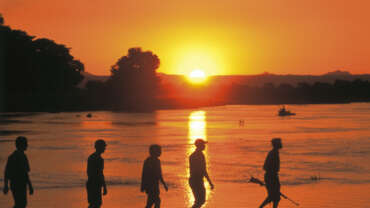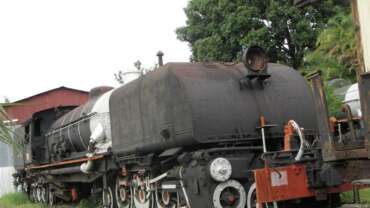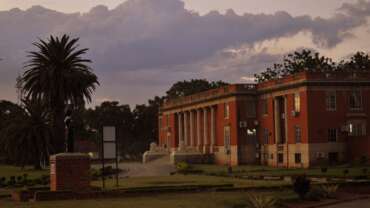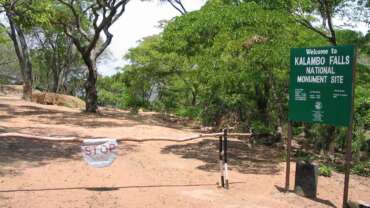Vast Lakes in Zambia
Despite being landlocked, there can be few places in the world as blessed as Zambia when it comes to water resources. And the nation’s vast and beautiful lakes are as breath-taking as the mighty Zambezi River and Victoria Falls. Lake Tanganyika is the longest lake in the world, while Lake Kariba is Africa’s largest man-made dam and rapidly becoming Zambia’s very own French Riviera. For the more intrepid traveller, the tropical and wild Lake Mweru offers a fascinating glimpse of village lif that lines the shores of this vast lake in th far north…overall, they are well worth a visit.
LAKE BANGWEULU
When one looks out over Lake Bangweulu, the grey blue waters disappear into the horizon, blending in completely with the colour of the sky. It is difficult to tell just where the horizon is. ‘Bangweulu’ means ‘The Place Where the Water Meets the Sky.’
The Lake is exploited more as a fish source than for its tourist potential. This is unfortunate, as it’s beauty is breathtaking. There are rumours of developing a tourist resort and having a luxury cruise boat for hire. But for the moment this is a an interesting stopover for the intrepid vehicle traveller or backpacker.
The main catches in the Lake are Cychlids (bream, tigerfish, yellow belly) and catfish. About 57 000 metric tons of fish are harvested from the Lake each year. Although fish stocks are not in danger, catches are declining and the favoured species are becoming thinner.
The fisheries of the Bangweulu are one of the largest in Zambia. This has lead to some of the highest population densities around the Lake where commercial fishermen have settled. Nevertheless the fishing industry is not economically well developed and inadequate controls and marketing facilities threaten both sustainability and profitability of the industry as a whole. Many of the fishermen trade their catches purely on a barter system for essential commodities.
Samfya is the largest town on the Lake, developed in the mid 1900s as a fishing village. You can get basic supplies as well as fresh fish. There is a post office, clinic and adequate fuel supplies.
LAKE KARIBA
Lake Kariba is Zambia’s undiscovered Riveira! It offers spectacular views, stunning sunsets, great fishing, boating opportunities, water sports or wonderful relaxing holidays or weekends just soaking up the sunshine.
The weather here is mostly sunny and fine. It can get quite hot in mid summer, but even mid winter days are warm and the nights are balmy.
This is Africa’s largest man made dam, 226km long and in places up to 40 km wide. It provides considerable electric power to both Zambia and Zimbabwe and supports a thriving commercial fishing industry. The sheer size of it makes one forget it’s a dam and in certain places it almost feels like an ocean!
A houseboat holiday is a great way to spend a few days under the sun, and the best time to plan it is over a full moon. The twilight atmosphere between sunset and full moon rise on this lake is quite magical.
Accommodation ranges from well established lodges on the banks with spectacular views to self catering chalets and campsites.
LAKE MWERU
This truly beautiful lake is located on the far north-west border of Zambia and is shared more or less equally with Zaire/DRC. The Luapula River flows in from the south having formed the official border between northern Zambia and Zaire. It also drains out from the lake in the north. The Kalungwishi river flows in from the east. Both river mouths form important deltas that serve as fish breeding grounds.
Not so long ago there were just a few villages dotted around the lake, but as the tar road arrived in Nchelenge in 1987, so the population increased as people began to make a living from the wealth of the Lake. The area, once surrounded by wildlife became peri-urban and the animals that weren’t poached drifted off to quieter areas. Now there are thousands of people living on the shores of this massive expanse of water which provides both food and a means of living.
Lake Mweru, although off the beaten track, is worth a visit. The lake has spawned a dynamic population, rich in culture, fervent in trade and colourful in nature. The area is almost a microcosm of what Tropical Africa could be if left to its own devices.
Tourist facilities, however are limited to a few ‘guesthouses’ of varying standards. Water temperatures range from 21o C to 29o C. While air temperatures range from 27.5o C to 35o C. The lake is chemically very fertile and contributes substantially to the fishing industry in Zambia.
Known to only a handful of visitors, the lake lies on the edge of Mweru Wantipa National Park. Though the thriving crocodile and elephant populations once found within the National Park have been almost entirely wiped out by poaching, the park remains a good place for viewing various waterbirds and a good spot for camping. There are also a number of scenic waterfalls along the Luapula River that feeds the lake, and the countless small villages you pass by help to further enliven the journey.
The road south from the lake is mostly good tar road all the way back to Ndola, beside the odd pothole, whilst the gravel road heading north-east towards Lake Tanganyika is also fairly comfortable.
LAKE TANGANYIKA
This vast inland sea was first made known to the European world in the mid 1800’s by the English explorers Richard Burton and John Speke. They pursued it as the source of the Nile, arriving at its shores in February of 1858, only to discover that the Ruzizi River in the north, which they thought to be the Nile, flowed into and not out of the lake. (Their incredible journey is documented in the movie ‘Mountains of the Moon’.)
Tanganyika’s waters lap Tanzania, Burundi, Congo DR and Zambia. It is the longest fresh water lake in the world and the second deepest after lake Baikal in Russia. The immense depth is because it lies in the Great Rift Valley, which also has created its steep shoreline. It reaches a depth of 1433 metres (4 700 feet), which is an astounding 642m below sea level.
Although Zambia can only lay claim to 7% of its surface area, it stretches north to south a distance of 677 kilometres (420 miles) and averages about fifty kilometers wide (31 miles). The clear waters host more than 350 different species of fish and is well known for aquarium fish exports and excellent angling.
The fertile circulating surface water, although not tidal, provides abundant plankton for its inhabitants which in turn provides much needed protein for both the local and export markets. The stiff winds that blow off the surrounding mountains aid the continual movement which inhibits the spread of bilharzia, the parasitic disease carried by shallow water snails.
A LANDLOCKED SEA
It is essentially a landlocked sea but in years of heavy rain the lake overflows into the Lukuga River which in turn feeds Congo DR’s Lualaba River
Despite the ferocious surface storms that occur, driving waves up to six meters high (20 foot), no mixing of the lower relict waters occur. The bottom 1 200 meters of the lake remain ‘dead’ – either too high in hydrogen sulphide or too low in oxygen to support life. This ‘fossil water’ may be as old as 20 million years. By contrast, the oceans, because of currents and upwellings have life forms even as low as 11000 meters (36 080 feet).
Lake Tanganyika has a remarkably uniform temperature. The lower regions are only a mere 3° C colder than the surface. The reason for this strange phenomenon has yet to be discovered.
TROPICAL FISH
Lake Tanganyika boasts over 350 species of fish of which most are endemic. Like Lake Malawi, Lake Tanganyika is extremely old, and the combination of its age and ecological isolation has led to the evolution of unique fish populations. Since new species are being discovered continually in these remarkable lakes, it is difficult to determine which has the highest diversity, but they at least share the distinction of being the top two lakes in the world in terms of biodiversity, whilst Lake Tanganyika has the highest proportion of endemicity, concentrated mainly in the Zambian waters of the lake.
The Lake Tanganyika Biodiversity Project has been set up to ensure that its biological diversity is maintained. The aim of the project is to produce an effective and sustainable system for managing and conserving the biodiversity of Lake Tanganyika. As Lake Tanganyika is a border for four countries Zambia, Burundi, Democratic Republic of Congo- the success of the project will depend on how well these countries work together. The project which began in 1995 comes to an end in the year 2000 and is funded by the Global Environmental Facility through United Nations Development Programme (UNDP).
Species of particular note include the Giant Nile Perch (Lates angustifrons) and Small Nile Perch (Luciolates stappersii) which are important commercial and sports fishing (that is angling) species, Goliath Tiger (Hydrocynus goliath) and the English Fish or Lake Tanganyika yellow-belly (Boulengerochromis microlepis) which are important angling species (the latter being especially prized for its good eating), the Kapenta (Limnothrissa miodon) which is an important source of fish-protein in Zambia, the rare Bichir (Polypterus congicus), and a great variety of endemic Cichlids.



